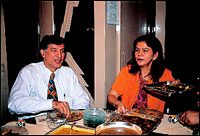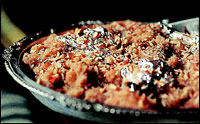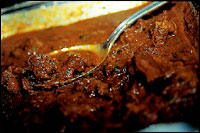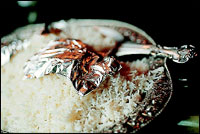


|
|
|
FOR years a great debate has raged over Sindhi food. Gourmets in Bombay cannot decide whether the cuisine is better here in India, where the community settled after Partition, or in Pakistan, where a limited number of Hindu Sindhis continue to live in Sindh. The argument goes that the River Indus, which flows through Sindh, plays an important role in the lives of this community and influences almost everything about them. Especially their cuisine and eating habits.
From the Indus, the Sindhis get the sweetwater fish and the lotus stem (bhee) for their cooking pots. They like the Hilsa, which is a river fish, and with the lotus stem, they make a curried dish which goes well with rice. So, the food is certainly more authentic if not better in Pakistan due to the Indus, some Sindhis say.
The Bombay Sindhis pooh-pooh this suggestion. It is true that they have infused the local cuisine with their own flavours, and that their food is now more varied. But it is still traditional Sindhi cuisine. As for sweetwater fish and lotus stem, the Sindhis are an enterprising people, they make do with is available in the lakes, ponds and rivers around Bombay. And there is also the Pomfret here which the Sindhis in Sindh do not have. The debate continues. . .
The lunch was authentic Sindhi, the Harish family�s distinguished Sindhi guests gave it their certificate of approval. There was industrialist Prakash Hinduja and wife Kamal, both staunch vegetarians, the builders Niranjan Hiranandani and Meena Raheja, veteran social worker and lawyer Nari Gurshahani (Honey�s father) and Ratna Harish (Anil�s mother). Honey had done the cooking in her modern Bombay flat aided by a team of cooks from Uttar Pradesh who appeared to specialise in Sindhi food.
The Hindujas, who live in Geneva, London and Bombay, and who are used to eating in the great restaurants of the world, said that they managed to squeeze a Sindhi meal into the lifestyles at least three times a week. Otherwise, there was some Sindhi dish in their menu every day. Being the Hindujas, they naturally do a lot of eating out and entertaining, and their dinner menus at home for foreign business associates is always Indian-Sindhi. �There is no question of us missing traditional Sindhi food in Geneva or London,� said Prakash Hinduja, �because my wife Kamal makes it all the time.�
Indeed there is. The simple Sindhi Kadi, for instance, which is a gram flour, lentil and vegetable curry, is a delicacy because the various ingredients that go into its making create a mouth-watering concoction that is also wholesome. And the Sai Bhaji, another ubiquitous Sindhi dish, is as nutritious as it is famous. Spinach is the main ingredient, in addition to which there are at least eight other vegetables, pulses, the simplest of spices. And their breads, the spicy paratha-like Koki and the sweet-stiff Lolo, are both made of whole wheat.
Niranjan Hiranan-dani carries a Sindhi tiffin to work every day. �In this, dal and papad must be there,� he said. �It is a habit with me and a tradition with Sindhis to have dal and papad with every meal.� Sundays at the Hiranandani home are reserved for Sindhi meals. �We tend to gravitate towards our roots,� he said. �Otherwise, thanks to my children, different kinds of foods have moved into the house, like Chinese food and pizza.� Of the Sindhi habit of eating papads, Niranjan said, �Sindhi and Rajasthani food is similar, however, Rajasthanis serve papads at the end of the meal. We have it at the start, middle and end! It is like a snack.�
So what is unique about Sindhi food? Its chaats and breakfast foods, the festival foods, meetha chawal or Tahiri made of rice, ghee, saffron, sugar, elaichi, the vast range of non-vegetarian dishes, Bheja Fry and Methi Gosht, the evening snacks of Bhee Aloo Tikki and Kheema Samosas, and an exciting collection of pickles made at home, like Chunda, Amb Khatta, Kat Keri, Bheendi Khatti, Sai Chutney � simple green coriander mixed with onion, ginger, garlic, green chillies, cumin seeds, the juice of lemon, and salt. Although Sindhis believe that their food is so tasty that it requires no pickles and chutneys.
|

Home Page
About the mag
Subscribe
Advertise
Contact Us
 Sai Bhaji & Methi Fish
Sai Bhaji & Methi Fish
 To see what an authentic Sindhi meal was like, UpperCrust had lunch with Anil and Honey Harish (of the famous law firm D. M. Harish) on a Sunday afternoon. There was Dal Pakwan, a channa dal and puri; Sindhi Kadi, Chawal and Sweet Boondi, the kadi made of beans, yam, brinjal, pumpkin, ladies finger, potato, and besan, and flavoured with tamarind; Aloo Tuk; a spicy potato pattice; Sai Bhaji; the Sindhi signature dish full of green vegetables and served with rice; Fried Baingan; Methi Fish; Sindhi Mutton; a rich curried dish flavoured with cardamom; and Sooji Ka Seera, the semolina fried in ghee till it turns golden brown, then sweetened with sugar and water and eaten with puri.
To see what an authentic Sindhi meal was like, UpperCrust had lunch with Anil and Honey Harish (of the famous law firm D. M. Harish) on a Sunday afternoon. There was Dal Pakwan, a channa dal and puri; Sindhi Kadi, Chawal and Sweet Boondi, the kadi made of beans, yam, brinjal, pumpkin, ladies finger, potato, and besan, and flavoured with tamarind; Aloo Tuk; a spicy potato pattice; Sai Bhaji; the Sindhi signature dish full of green vegetables and served with rice; Fried Baingan; Methi Fish; Sindhi Mutton; a rich curried dish flavoured with cardamom; and Sooji Ka Seera, the semolina fried in ghee till it turns golden brown, then sweetened with sugar and water and eaten with puri. �It is a fairly easy cuisine to make at home,� Honey Harish explained. �The recipes are simple, the ingredients all locally available, the spices are always fresh, especially when making garam masala, we don�t use the market powders, and contrary to general belief, Sindhis don�t use sugar in the food. Nor do we use yoghurt, khoya, those kinds of things. And what is important is that our cuisine is very balanced. There is variety, there is taste, and there is nutrition in the simplest of foods.�
�It is a fairly easy cuisine to make at home,� Honey Harish explained. �The recipes are simple, the ingredients all locally available, the spices are always fresh, especially when making garam masala, we don�t use the market powders, and contrary to general belief, Sindhis don�t use sugar in the food. Nor do we use yoghurt, khoya, those kinds of things. And what is important is that our cuisine is very balanced. There is variety, there is taste, and there is nutrition in the simplest of foods.� Meera Raheja, a bubbling socialite in Bombay, will have completely authentic Sindhi meals four times a week. �Caloriewise, Sindhi food is very healthy,� she said. To which, Prakash Hinduja heartily agreed. He was a stickler for vegetarian Sindhi food. At home, he gave the Hinduja cooks instructions. And when he travelled, his secretary e-mailed his dietary and culinary preferences to the big chefs of the hotels that drew his custom. What is amazing is that the entire Hinduja family, all the brothers, their wives, the children, the new in-laws, everybody was vegetarian. �Or we convert them,� said Kamal Hinduja.
Meera Raheja, a bubbling socialite in Bombay, will have completely authentic Sindhi meals four times a week. �Caloriewise, Sindhi food is very healthy,� she said. To which, Prakash Hinduja heartily agreed. He was a stickler for vegetarian Sindhi food. At home, he gave the Hinduja cooks instructions. And when he travelled, his secretary e-mailed his dietary and culinary preferences to the big chefs of the hotels that drew his custom. What is amazing is that the entire Hinduja family, all the brothers, their wives, the children, the new in-laws, everybody was vegetarian. �Or we convert them,� said Kamal Hinduja.